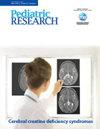Utility of urinary NT-proBNP in congenital diaphragmatic hernia: a prospective pilot study
IF 3.1
3区 医学
Q1 PEDIATRICS
引用次数: 0
Abstract
Echocardiography is the reference standard for diagnosing pulmonary hypertension (PH) and cardiac dysfunction (CD) in congenital diaphragmatic hernia (CDH). The use of an adjunct non-invasive biomarker would be invaluable. Plasma N-terminal brain Natriuretic Peptide (NT-proBNP) has been evaluated as a biomarker in CDH. Our objective was to investigate the utility of urinary NT-proBNP as an adjunct biomarker in CDH. Prospective observational study of neonates with CDH. Urinary NT-proBNP and its ratio to urinary creatinine (UNBCR) were analyzed at 24 h of life (HOL). Spearman’s correlation was used to quantify the association between the urinary NT-proBNP with corresponding plasma concentrations. Logistic regression and receiver operating characteristic (ROC) curve analyses were used to examine urinary NT-proBNP and UNBCR’s association with need for ECMO. The Kruskal–Wallis test was used to compare urinary NT-proBNP concentrations with echocardiography parameters of PH and CD. Urinary NT-proBNP and UNBCR positively correlated with plasma concentrations. Patients with high right ventricular (RV) pressures had higher urinary NT-proBNP concentrations. Both urinary NT-proBNP and UNBCR concentrations increased with worsening left and right ventricular dysfunction on first postnatal echocardiogram. We report the feasibility of urinary NT-proBNP as a non-invasive biomarker to assess PH and CD in CDH.

尿液 NT-proBNP 在先天性膈疝中的应用:一项前瞻性试验研究。
背景:超声心动图是诊断先天性膈疝(CDH)患者肺动脉高压(PH)和心功能不全(CD)的参考标准。使用辅助性无创生物标志物将非常有价值。血浆 N 端脑钠肽 (NT-proBNP) 已被评估为 CDH 的生物标志物。我们的目的是研究尿液 NT-proBNP 作为 CDH 辅助生物标记物的实用性:方法:对 CDH 新生儿进行前瞻性观察研究。方法:对患有 CDH 的新生儿进行前瞻性观察研究,分析出生后 24 小时(HOL)的尿液 NT-proBNP 及其与尿肌酐的比值(UNBCR)。Spearman 相关性用于量化尿液 NT-proBNP 与相应血浆浓度之间的关联。利用逻辑回归和接收器操作特征曲线分析来研究尿液 NT-proBNP 和 UNBCR 与 ECMO 需求的关系。Kruskal-Wallis检验用于比较尿液中NT-proBNP浓度与PH和CD的超声心动图参数:结果:尿NT-proBNP和UNBCR与血浆浓度呈正相关。右心室(RV)压力高的患者尿中NT-proBNP浓度更高。尿液中的NT-proBNP和UNBCR浓度均随着出生后首次超声心动图检查中左心室和右心室功能障碍的恶化而增加:我们报告了尿NT-proBNP作为无创生物标志物评估CDH患者PH和CD的可行性:无创生物标志物是新生儿研究的一个重要领域,因为它们有可能减少对抽血的需求,而抽血可能会导致疼痛、压力和诱发先天性贫血。无创生物标志物的使用对先天性膈疝(CDH)患者尤其有用,因为他们可能需要体外生命支持(ECLS)来治疗。我们评估了尿液 NT-proBNP 在 CDH 中的潜在作用。血浆 NT-proBNP 已在 CDH 新生儿中进行过研究;但是,尿液 NT-proBNP 还没有被研究过,因此,这是首次研究尿液 NT-proBNP 作为生物标记物的潜力。
本文章由计算机程序翻译,如有差异,请以英文原文为准。
求助全文
约1分钟内获得全文
求助全文
来源期刊

Pediatric Research
医学-小儿科
CiteScore
6.80
自引率
5.60%
发文量
473
审稿时长
3-8 weeks
期刊介绍:
Pediatric Research publishes original papers, invited reviews, and commentaries on the etiologies of children''s diseases and
disorders of development, extending from molecular biology to epidemiology. Use of model organisms and in vitro techniques
relevant to developmental biology and medicine are acceptable, as are translational human studies
 求助内容:
求助内容: 应助结果提醒方式:
应助结果提醒方式:


